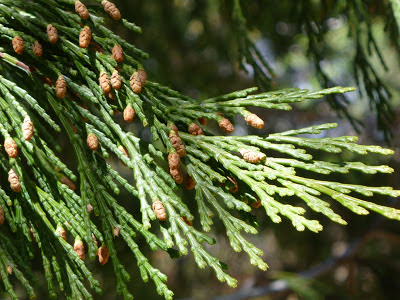The incense cedar (Calocedrus decurrens) is a coniferous tree of the western United States and northwest Mexico [1,2]. The shown branches and bark belong to a tall tree in David's Grove of the Wilbur D. May Arboretum and Botanical Garden in Reno, Washoe County, Nevada. Other names for this tree species of the cypress family (Cupressaceae) are white, bastard, and California post cedar, for which Donald Culross Peattie gives the following range description [1]:
The evergreen trees show a bright green foliage of scale-leaves. The tiny yellowish brown pollen cones at the branch tips can be seen in the picture. The bark at the lower trunk is grayish pink to cinnamon red. Exfoliation of the bark as brittle plates and long strips becomes common for older trees. If you happen to find a cedar with charcoal-colored bark on the trunk—like being scorched, the darkened bark may be caused by growth of sooty mold (Arthrobotryum spongiosum), a non-pathogenic fungus [3].
Keywords: botany, trees, evergreens, cypress family (Cupressaceae).
References and more to explore
[1] Donald Culross Peattie: A Natural History of North American Trees. Houghton Mifflin Company, New York, 2007 (originally published in 1950 and 1953).
[2] USDA Plants Profile: Calocedrus decurrens (Torr.) Florin [plants.usda.gov/java/profile?symbol=CADE27].
[3] MyMotherload: Incense Cedar Scales [www.mymotherlode.com/news/local/2069306/Incense-Cedar-Scales-.html].
Both east and west slopes of the Cascade Range in Oregon, from the foothills to 6600 feet, and south through the Sierra Nevada, and Coast Ranges of California (3000 to 9700 feet) to the Sierra San Pedro Mártir in Baja California. Also in Washoe County, Nevada.
The evergreen trees show a bright green foliage of scale-leaves. The tiny yellowish brown pollen cones at the branch tips can be seen in the picture. The bark at the lower trunk is grayish pink to cinnamon red. Exfoliation of the bark as brittle plates and long strips becomes common for older trees. If you happen to find a cedar with charcoal-colored bark on the trunk—like being scorched, the darkened bark may be caused by growth of sooty mold (Arthrobotryum spongiosum), a non-pathogenic fungus [3].
Keywords: botany, trees, evergreens, cypress family (Cupressaceae).
References and more to explore
[1] Donald Culross Peattie: A Natural History of North American Trees. Houghton Mifflin Company, New York, 2007 (originally published in 1950 and 1953).
[2] USDA Plants Profile: Calocedrus decurrens (Torr.) Florin [plants.usda.gov/java/profile?symbol=CADE27].
[3] MyMotherload: Incense Cedar Scales [www.mymotherlode.com/news/local/2069306/Incense-Cedar-Scales-.html].
















No comments:
Post a Comment